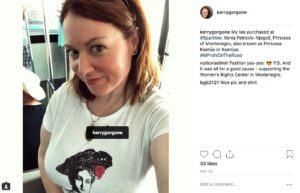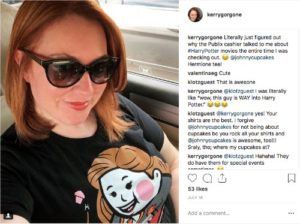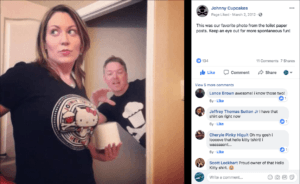
By Kerry Gorgone, {grow} Contributing Columnist
I’m a sucker for a good story. If you’ve ever wondered who reads the text on the back of a bag of Pepperidge Farm cookies … it’s me. And as any marketer knows, a good story can capture a prospective buyer’s imagination, inspiring them to purchase something they’d otherwise pass by.
Take the Christmas pickle ornament, for example. Back in the late 1800s, Woolworth’s sold a collection of tree ornaments, glass fruits and vegetables. Apparently, the pickle wasn’t a big seller, until the store began to tell people about the “German tradition” of hiding a pickle in the Christmas tree.
The person who found the pickle on Christmas morning, the story goes, would enjoy good fortune in the coming year. There are other origin stories of the Christmas pickle ornament, some involving a civil war soldier and others a rather gruesome legend involving pickle barrels. (You can check out the warring theories here.)
But the main takeaway for marketers is this: the story of the Civil War soldier / gruesome pickle barrel legend / “German tradition” got people to buy glass pickle ornaments and hang them on their Christmas trees. In fact, that story sparked a new holiday tradition that many, many U.S. households still observe. (Can’t say the same about German revelers, most of whom have apparently never heard of the Christmas pickle.)
The fact that this particular story was total BS is almost beside the point. I say “almost” because an authentic story has an important advantage: you can add to it as your brand evolves. You can fold in customer and employee stories, exponentially increasing the potency of your narrative.
Storytelling sells
But storytelling works in any context. People will buy if they like your story. Getting back to my own love of product packaging and brand storytelling, I have a weakness for t-shirts, particularly when there’s a good story I can tell about one.
Recently, I was in Montenegro for the first time, speaking at the Spark.Me conference. As I meandered through the crowded event space, talking with attendees and other speakers, I spotted a small group of women selling t-shirts. All the shirts sported the same portrait of an elegant looking woman from a bygone era. I would have kept walking after a brief glance, but then I saw the pamphlet.
 The woman on the t-shirt was Princess Xenia of Montenegro, whose independence and self-direction made her something of a feminist icon. After reading her story and seeing that proceeds from my purchase would benefit the Women’s Rights Center in Montenegro, I bought my only souvenir tee from that trip.
The woman on the t-shirt was Princess Xenia of Montenegro, whose independence and self-direction made her something of a feminist icon. After reading her story and seeing that proceeds from my purchase would benefit the Women’s Rights Center in Montenegro, I bought my only souvenir tee from that trip.
But that’s hardly the first time I’ve plunked down money for a t-shirt based on its backstory. I have a huge collection of designer tees from Johnny Cupcakes, “the world’s first t-shirt bakery.” The company’s been one of my favorite brands since I discovered these sweet shirts back in 2008.
Founder Johnny Earle needed a t-shirt for his band, so he came up with his now-famous design featuring a cupcake and crossbones. His inspiration was a nickname coworkers had for him when he worked at Newbury Comics in Massachusetts: “Johnny Cupcakes.”
When people saw him wearing the shirt, they wanted one of their own. The rest, as they say, is history. You can read Johnny’s whole story here: it’s a good ‘un!
For the love of Cupcakes
Clearly, I like a good origin story, but there’s more to my love of Johnny Cupcakes than his beginning. Over the years, Johnny’s stayed true to his own vision for the t-shirt line and the brand, building one-of-a-kind retail locations (“t-shirt bakeries”). He has a natural talent for creating a brand experience that carries through every touchpoint: his personal style comes across on the Johnny Cupcakes website, in the company’s weekly emails about “fresh baked” tees, and even in the product packaging, unmistakable with its cupcake crossbones.
 Johnny Cupcakes also partners with other brands to create shirts featuring beloved characters like “Hello Kitty,” “Ghostbusters,” and “Harry Potter.” (I have tees of all three, as well as the “Hocus Pocus” shirt for Halloween.) I’m able to express my affinity for Johnny Cupcakes and my not-so-hidden inner geek, just by throwing on a tee. In effect, I’m able to layer my personal stories (Harry Potter geek and Johnny Cupcakes fan).
Johnny Cupcakes also partners with other brands to create shirts featuring beloved characters like “Hello Kitty,” “Ghostbusters,” and “Harry Potter.” (I have tees of all three, as well as the “Hocus Pocus” shirt for Halloween.) I’m able to express my affinity for Johnny Cupcakes and my not-so-hidden inner geek, just by throwing on a tee. In effect, I’m able to layer my personal stories (Harry Potter geek and Johnny Cupcakes fan).
The Johnny Cupcakes brand story has proven to create a powerful bond among like-minded fans. A few years ago, I wore one of the brand’s hoodies at a SXSW event and a twenty-something man shouted at me from across the room, “HEY, Johnny Cupcakes!” When I looked up, he smiled and gave me a thumbs up. What makes this especially fun for me is that I haven’t been twenty-something since the early 2000s. (Shhh.)
So my love of Johnny Cupcakes began with his origin story, but since then, he’s made me part of the brand story, along with everyone else who wears and loves his tees. Take this 2012 Facebook, post, for example: Johnny had challenged his followers to take a photo of themselves wearing a Johnny Cupcakes tee, holding toilet paper, and looking serious.
 I was over the moon when he selected my submission and posted it to the brand’s fan page!
I was over the moon when he selected my submission and posted it to the brand’s fan page!
Over the years, Johnny Cupcakes has constantly engaged in social listening, as well, liking and commenting on my Instagram posts featuring their “baked goods.”
Storytelling lessons
The lesson for brands is simple: don’t sell, tell a story. Then make the people you serve part of that story. The personal connection will last, and will translate into a much higher customer lifetime value. I could buy a t-shirt anywhere, but I’ve bought (and gifted) dozens of Johnny Cupcakes “freshly baked” tees over the years.
Here’s the moral of the story: tell, don’t sell.
Share your origin story, and why you love what you do.
The story of how Johnny Earle became “Johnny Cupcakes” inspired me to purchase my first “freshly baked” tee back in 2008. What’s kept me coming back is his willingness to share his entrepreneurial journey, and his invitation to all the brand’s fans to be part of it.
Share the story of your commitment to a cause or a movement.
In Montenegro, I bought a shirt showing Princess Xenia because I liked her story, but also because I wanted to support women’s rights. As a brand, you have principles. Live by them, and people will support you with their dollars. When Nike ran a campaign featuring Colin Kaepernick, for example, Labor Day sales jumped 31%.
Share any intriguing story (although true is better).
Woolworth’s might have fabricated the “Christmas pickle” tradition, but the story of the pickle ornament captured people’s imagination, inspiring them to incorporate it into their real holiday traditions. At this point, the origin of the story is almost irrelevant: thousands upon thousands of people have made the pickle part of their own narrative. The pickle’s patina might be borrowed, but a new tradition is as powerful for driving sales as an old one. (Just ask the people who invented “Elf on the Shelf.”)
So what’s your story?

Kerry O’Shea Gorgone is a writer, lawyer, speaker and educator. She’s also Director of Product Strategy, Training, at MarketingProfs. Kerry hosts the weekly Marketing Smarts podcast. Find Kerry on Twitter.
The post Tell, Don’t Sell: Use Storytelling to Get (and Keep) Your Audience’s Attention appeared first on Schaefer Marketing Solutions: We Help Businesses {grow}.
from {grow} http://feeds.feedblitz.com/~/569253472/0/markgrow~Tell-Dont-Sell-Use-Storytelling-to-Get-and-Keep-Your-Audiences-Attention/
No comments:
Post a Comment